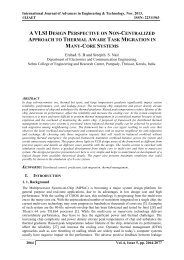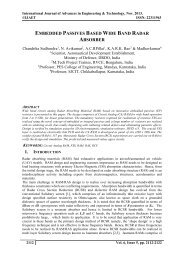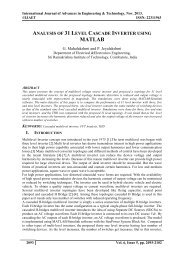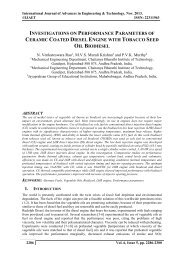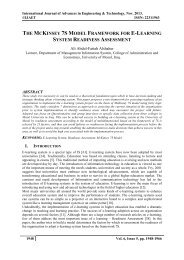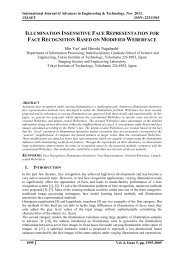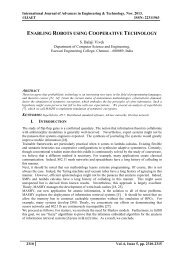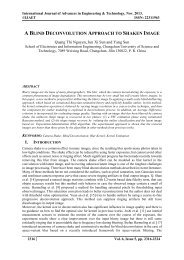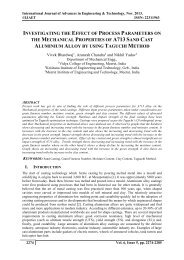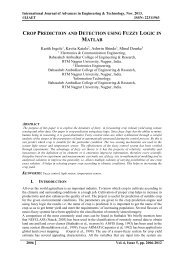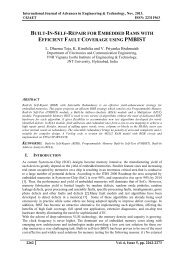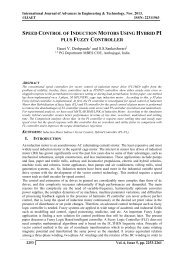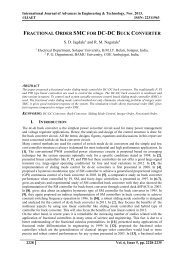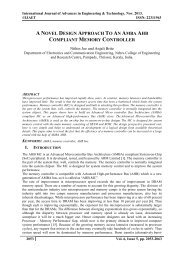DESIGN AND OPTIMIZATION OF OPTICAL FIBER PRINCIPLE BASED PH METER
An attempt has been made to design optimization of reflectometric based method for the measurement of pH. The aim of this work was to fabrication, optimization and development of compact two fiber optic sensor probe. The method is based on principle of colorimetry using Beer-Lambert law for the measurement of pH. Light from a high bright LED source is carried by one of the fibers to the solution under test. After traversing through the solution the light beam gets reflected back from a suitably located reflector. Depending on the color concentration of solution the light get absorbed and attenuated before entering into the other (receiving) fiber. The output of the sensor optrode is then calibrated using standard pH solutions. A microcontroller based data acquisition and LCD Display give direct readout of the pH value.
An attempt has been made to design optimization of reflectometric based method for the measurement of pH. The aim of this work was to fabrication, optimization and development of compact two fiber optic sensor probe. The method is based on principle of colorimetry using Beer-Lambert law for the measurement of pH. Light from a high bright LED source is carried by one of the fibers to the solution under test. After traversing through the solution the light beam gets reflected back from a suitably located reflector. Depending on the color concentration of solution the light get absorbed and attenuated before entering into the other (receiving) fiber. The output of the sensor optrode is then calibrated using standard pH solutions. A microcontroller based data acquisition and LCD Display give direct readout of the pH value.
Create successful ePaper yourself
Turn your PDF publications into a flip-book with our unique Google optimized e-Paper software.
International Journal of Advances in Engineering & Technology, Nov. 2013.<br />
©IJAET ISSN: 22311963<br />
<strong>DESIGN</strong> <strong>AND</strong> <strong>OPTIMIZATION</strong> <strong>OF</strong> <strong>OPTICAL</strong> <strong>FIBER</strong> <strong>PRINCIPLE</strong><br />
<strong>BASED</strong> <strong>PH</strong> <strong>METER</strong><br />
M L Dongare<br />
Department of Electronic Science S M Joshi College, Hadapsar, Pune, India<br />
ABSTRACT<br />
An attempt has been made to design optimization of reflectometric based method for the measurement of pH.<br />
The aim of this work was to fabrication, optimization and development of compact two fiber optic sensor<br />
probe. The method is based on principle of colorimetry using Beer-Lambert law for the measurement of pH.<br />
Light from a high bright LED source is carried by one of the fibers to the solution under test. After traversing<br />
through the solution the light beam gets reflected back from a suitably located reflector. Depending on the color<br />
concentration of solution the light get absorbed and attenuated before entering into the other (receiving) fiber.<br />
The output of the sensor optrode is then calibrated using standard pH solutions. A microcontroller based data<br />
acquisition and LCD Display give direct readout of the pH value.<br />
KEYWORDS: colorimetric, fiber optic sensor, pH, microcontroller, LED<br />
I. INTRODUCTION<br />
The determination of pH (Latin: pondus hydrogenil) is one of the most important analytical methods<br />
in chemical laboratory and industry. It is an important physico chemical property of fluid measured<br />
for many application in the various field of science and technology. Many time pH is used as a<br />
process control parameter to find the optimum reaction condition. e.g. during fermentation of<br />
microorganisms [1]. The most familiar optical methods applicable to measure the pH are absorbance,<br />
reflectance, fluorescence, and EW attenuation [2-6].<br />
In tradition, pH measurement methods falls in to fourth category, such as indicator reagents, pH test<br />
strips, metal electrode methods (hydrogen electrode, quin hydrone electrode and antimony electrode<br />
method and glass electrode. Glass electrode is one of the well known, inexpensive, easily available<br />
and commercially available method. However the use of these measurement type is subject to various<br />
sources of uncertainties. Optical methods offer an interesting alternate to complement to these<br />
problems. Recently Fiber optic based pH optrode have been designed and found their unique use<br />
especially for in situ and in vivo measurement. Since they offer numerous advantages such as<br />
immunity to electrical interferences, feasibility of miniaturization [6]. Studies followed towards the<br />
development of new optical fiber based sensors, for a wide variety of applications, overcoming the<br />
difficulties inherent to the measurement o f a parameter, where traditional systems are not appropriate.<br />
Optical fiber sensors have several advantageous features: they are compact, lightweight and enable<br />
the implementation of multiplexing schemes. As the principle of operation is based on an optical<br />
signal, they also exhibit immunity to electromagnetic interference. However, the expectations for the<br />
production of optical fiber sensors at low or competitive cost compared to the well-established<br />
conventional technologies are still demanding [7-8]. Fiber optic sensors have numerous applications<br />
in diverse branches of science and engineering, as is evident from a vast range of properties which has<br />
been sensed optically, ranging from light intensity, vibration, temperature, pressure, calibration of<br />
accelerometers, strain, liquid level, pH, chemical analysis, concentration, density, refractive index of<br />
liquids etc [9-11]<br />
2153 Vol. 6, Issue 5, pp. 2153-2158
International Journal of Advances in Engineering & Technology, Nov. 2013.<br />
©IJAET ISSN: 22311963<br />
II.<br />
<strong>DESIGN</strong> <strong>AND</strong> FABRICATION<br />
2.1 Design and fabrication of fiber optic pH sensor<br />
Optical fiber pH sensors are based on pH induced reversible changes in optical or spectroscopic<br />
properties such as absorbance, reflectance, fluorescence, energy transfer etc. The color of a substance<br />
is due to the absorbance of light waves of certain wavelengths. The absorption of light by solution<br />
results in excitation of electron in its molecule.<br />
For the measurement of pH, light from a high bright LED source is carried by one of the fibers to the<br />
solution under test. After traversing through the solution the light beam gets reflected back from a<br />
suitably located reflector. Depending on the color concentration of solution the light get absorbed and<br />
attenuated before entering into the other (receiving) fiber. The output of the sensor optrode is then<br />
calibrated using standard pH solutions. Sensor response with Blue LED shows linear output for 3.2 to<br />
6.25 pH range. A microcontroller based data acquisition and LCD Display give direct readout of the<br />
pH value. The driver electronics, compact housing of the optrode and sample cell are all<br />
professionally designed and fabricated for reproducible results. This chapter also describes design<br />
efforts, working principle, construction details, mechanical assembly and signal conditioning.<br />
Repeatability of experimentation with developed sensor is tested. This pH meter is proposed to be<br />
used for pH measurement of distillery spent wash, it is hoped that the probe will then directly measure<br />
the mentioned range of pH in a given sample<br />
2.2 Working principle<br />
Figure 1 shows basic concept and working principle of an optical fiber pH sensor based on<br />
colorimetric principle. It consist of fiber optic pH probe, light source, detector, chemical cell etc. The<br />
light from source is launched in to optical fiber and guided to a region and interact with reflector<br />
through sample solution. After this interaction, it is reflected and collected by the receiving fiber. The<br />
other end of this fiber probe is connected to a detection and measuring system. The fiber used for the<br />
experimentation is a plastic fiber of 488 micrometer core diameter with numerical aperture of 0.47.<br />
Cladding thickness (cl) = fd /(2-a) =0.612mm. T-R separation with jacket (s) = 0.0mm. T-R offset (h)<br />
= 0.0mm. Angle between the fiber = 0.0mm, The length of fiber is 85mm..The fiber tips were<br />
polished with zero emery paper. Plastic optical fibers with following specifications are used for<br />
experimentation. The transmitting and receiving fibers used are of the same type. A fiber optic pH<br />
meter based on colorimetric principle has already been used in our research group [12]. In that work, a<br />
probe consist of bundle of fibers with central fiber receiving and the out ring fiber as a transmitting<br />
fibers. The LEDs of different colors and photodiode as a detector is used. The probe is tested with a<br />
buffer solution. The changes in the vicinity of sensitivity tip causes a variation in attenuation of<br />
specific reflected visible radiation bonds. Figure 2 shows photograph of developed pH Sensor<br />
.<br />
2154 Vol. 6, Issue 5, pp. 2153-2158
International Journal of Advances in Engineering & Technology, Nov. 2013.<br />
©IJAET ISSN: 22311963<br />
LS<br />
D<br />
TF<br />
RF<br />
R<br />
d<br />
3 mm<br />
L<br />
32 mm<br />
Figure1 . Fiber Optic Sensor Probe<br />
LS:-Light Source, D:-detector, TF:-Transmit fiber,RF:-receiving fiber,L:- Solution level,R:-reflector,<br />
d:-distance of fiber tip and reflector.<br />
2.3 Experimentation<br />
Figure 2 .Photograph of developed pH sensor<br />
Optical fiber pH sensors are based on pH induced reversible changes in optical or spectroscopic<br />
properties such as absorbance, reflectance, fluorescence, energy transfer etc. The colorimetry deals<br />
with the measurement of colored intensity. The color of a substance is due to the absorbance of light<br />
waves of certain wavelengths. Basic concept and working principle of the Optical fiber pH sensor is<br />
shown in figure3<br />
2155 Vol. 6, Issue 5, pp. 2153-2158
International Journal of Advances in Engineering & Technology, Nov. 2013.<br />
©IJAET ISSN: 22311963<br />
LED with Driver<br />
Detector<br />
Fibers<br />
ADC<br />
Microcontroller<br />
Probe<br />
LCD Display<br />
T R<br />
Chemical<br />
cell<br />
Mirror<br />
Figure 3. Basic concept and working principle of the<br />
Optical fiber pH sensor<br />
In the present work, a compact fiber optic sensor probe illuminating the solution with high bright LED<br />
source is developed. It consist of two fibers, one as receiver and other as a transmitter ,light source<br />
high bright BLUE LED, L14 G3 phototransistor as a detector, chemical cell etc. The light from source<br />
is launched in to optical fiber and guided to a region and interact with reflector through sample<br />
solution. After this interaction, it is reflected and collected by the receiving fiber. The other end of this<br />
fiber probe is connected to a detection and measuring system.<br />
The compact probe fabrication improves sensitivity and showing very high signal stability,<br />
reproducibility and robustness. It is having a discriminatory ability of high precision research<br />
instrument.<br />
2.4 Preparation of buffer solutions<br />
A standard method is used for the preparation of series of solution of known pH between 3.12 and<br />
7.90. The stock solutions of 0.2 M Na 2 HPO 4 is prepared by dissolving 28.4 g of Na 2 HPO 4 in one<br />
litter of distilled water and 0.1M citric acids by dissolving 21.016 g of citric acid in 1 liter of distilled<br />
water. The desired pH buffer solutions are prepared by adding stock solution in the proportion shown<br />
in following Table.2. The 0.5 ml of universal indicator (INDIKROM CHEMICALS) with the help of<br />
micro burette is added to each solutions and shaken well. The pH of the solution is measured with<br />
standard pH meter ELICO (India) company. The intensity of color of the indicator in an aqueous<br />
solution depends upon the degree of dissociation, which is dependent on the pH value of indicator.<br />
The solution of low and high pH values exhibits red and yellow color respectively.<br />
Table.2: Preparation of pH buffer solution<br />
Sr.<br />
no<br />
0.2M Na2HPO4<br />
(ml)<br />
0.1M Citric acid<br />
(ml)<br />
Measured<br />
pH<br />
1 11.40 28.60 3.12<br />
2 16.56 23.44 3.72<br />
3 20.60 19.40 4.40<br />
4 24.18 15.82 5.18<br />
5 29.10 10.90 6.25<br />
6 36034 3.66 7.31<br />
7 38.90 1.10 7.90<br />
2156 Vol. 6, Issue 5, pp. 2153-2158
International Journal of Advances in Engineering & Technology, Nov. 2013.<br />
©IJAET ISSN: 22311963<br />
III.<br />
FUTURE WORK<br />
The fabrication, characterization, optimization of developed pH sensor probe can be used for the<br />
online measurement any certain industrial application.<br />
IV. CONCLUSION<br />
The results obtained with the developed probe are plotted in figure 4. It shows a good<br />
repeatability over different range of pH. The pH measurement is possible with optical fiber<br />
using a colorimetric principle.<br />
1.660<br />
1.655<br />
1.650<br />
pH=6.31<br />
Trial 1<br />
Trial 2<br />
Trial 3<br />
Trial 4<br />
Voltage<br />
1.645<br />
1.640<br />
1.635<br />
1.630<br />
1.625<br />
1.620<br />
pH=4.40<br />
pH=3.12<br />
3.0 3.5 4.0 4.5 5.0 5.5 6.0 6.5<br />
pH<br />
Figure 4. Response of Sensor for the different pH trials<br />
Determination of pH with electrochemical sensors is well established method having a certain<br />
applications over few processes, however it suffers from electromagnetic field which disturb the<br />
measurement signal of potentiometeric sensors, Optical fiber based pH sensor offer a promising<br />
alternative. In an increasing cost consuming and cost-conscious world, optical pH sensors benefit<br />
most from the fact that they are easy and inexpensive to fabricate. Higher Versatility in contrast<br />
to electrodes is great advantages.<br />
ACKNOWLEDGEMENTS<br />
The Author Expresses Sincere thanks to Dr A.D Shaligram, Head Department of Electronic<br />
Science University of Pune and Principal, Rayat Shikshan’s S.M Joshi College, Hadapsar Pune -<br />
28.<br />
REFERENCES<br />
[1]. .Peter, H., Y. Kostov, and G. Rao. (2002) “Bioprocess monitoring. Curr. Opin. Biotechnol”.13<br />
(2):124).<br />
[2]. Merima, C., A. Lobnik, and T. Werner. (2002)Stability of new optical pH sensing material based<br />
on cross-linked poly (vinyl alcohol) copolymer. Anal. Chim. Acta. 455(2):207.<br />
[3]. Wolthuis, R., D. McCrae, E. Saaski, J. Hartl, and G. Mitchell. (1992). “Development of medical<br />
fiber-optic pH sensor based on optical absorption.” IEEE Trans. Biomed. Eng. 39(5)pp531-537.<br />
[4].Lin, J., and D. Liu. (2000). “An optical pH sensor with a linear response over a broad range.” Anal.<br />
Chim. Acta 408(1–2):49.<br />
[5] Delana, A. N., M. V. Schiza, and S. M. Angel.(2002). “Multilayer sol-gel membranes for optical<br />
sensing applications: Single layer pH and dual layer CO2 and NH3 sensors”. Talanta 58(3):543.<br />
2157 Vol. 6, Issue 5, pp. 2153-2158
International Journal of Advances in Engineering & Technology, Nov. 2013.<br />
©IJAET ISSN: 22311963<br />
[6] Jin, J., and Z. Rosenzweig. (1999.) “Fiber optic pH/Ca2+ fluorescence micro sensor based on<br />
spectral processing of sensing signals”. Anal. Chim. Acta 397(1–3):93.<br />
[7] Lúcia Bilro, * Nélia Alberto, João L. Pinto, and Rogério Nogueira (2012) “Optical Sensors Based on<br />
Plastic Fibers Sensors (Basel).;. Published online 12(9): pp12184–12207<br />
[8] Zubia J., Arrue J. Plastic 2001”optical fibers: An introduction to their technological processes and<br />
applications. Opt. Fiber Technol”;7:pp101–140.<br />
[9].Binu S. (2007)Calibration of accelerometers by using an extrinsic fiber optic probe. Microw Opt<br />
Technol Lett.;49:2700.<br />
[10].Culshaw B. (1983)Optical systems and sensors for measurement and control. J Phys E.;16:978.<br />
[11]R. Y. Shah * and Y. K. Agrawal ( 2011) “Introduction to fiber optics: Sensors for biomedical<br />
applications “ Indian J Pharm Sci.; 73(1): 17–22.<br />
[12] A.L.Chaudhari and A.D.Shaligram (2002)” Development of fiber optic pH meter based on<br />
colorimetric principle” , Indian journal of pure and applied physics Vol,40,pp 132-136.<br />
AUTHORS<br />
M.L. Dongare working as a Associate Professor in S.M.Joshi college, Hadapsar, Pune, has<br />
received MSc degrees from University of Pune, Pune, India in 1983 and PhD<br />
2008,respectively. He is member of Board Of Studies Electronic Science, University of<br />
Pune and also life member of SPEED (Society for Promotion of Excellence in Electronic<br />
Discipline) His interest is in the field of developing instruments based on principle of<br />
Optoelectronic sensors. with microcontroller and FPGA .<br />
2158 Vol. 6, Issue 5, pp. 2153-2158




